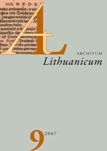Priesaginių veiksmažodžių daryba Ruigio, Ostermejerio ir Milkaus gramatikose
The derivation of Lithuanian suffixed verbs in the grammars of Ruhig, Ostermeyer and Mielcke
Author(s): Jurgis PakerysSubject(s): Theoretical Linguistics, Historical Linguistics, Baltic Languages
Published by: Lietuvių Kalbos Institutas
Keywords: Lithuanian suffixed verbs; Lithuanian language; Ruhig; Ostermeyer; Mielcke; Semantics; Morphology;
Summary/Abstract: The article presents further research results on the descriptions of verb formation in early Lithuanian grammars (cf. Pakerys 2006a). It reviews three eighteenth century works written and published in East Prussia: Anfangsgründe einer Littauischen Grammatick by Paul Friedrich Ruhig (Königsberg, 1747, RG), Neue Littauische Grammatik by Gottfried Ostermeyer (Königsberg, 1791, OG), and Anfangs-Gründe einer Littauischen Sprach-Lehre by Christian Gottlieb Mielcke (Königsberg, 1800, MG; largely based on RG). All three grammars include separate word formation chapters, which were missing in the earlier works on Lithuanian. These chapters are placed at the end of morphology sections and describe non-deverbative secondary verbs, while deverbatives are discussed beside inflexional morphology. The grammars of Ruhig and Mielcke have separate short chapters on the deverbative formations, whereas Ostermeyer briefly comments on some of them in the lists of verbs (syllabi verborum). A few notes on verb formation can be also found in the sections on syntax. Ruhig and Mielcke explain derivational semantics as one of three semantic layers of the word. According to them, any derivative has an additional meaning (zufällige Bedeutung) which exists beside lexical (eigentliche Bedeutung, Hauptidee) and grammatical (Nebenbedeutung) meanings. Ostermeyer does not go into details and uses word formation features only to classify the verbs according to the derivational processeses and categories into certain groups (Arten).
Journal: Archivum Lithuanicum
- Issue Year: 2007
- Issue No: 09
- Page Range: 183-214
- Page Count: 32
- Language: Lithuanian

